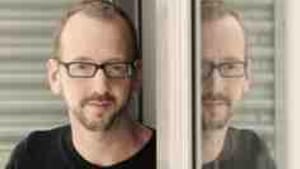Stay in the Loop
BSR publishes on a weekly schedule, with an email newsletter every Wednesday and Thursday morning. There’s no paywall, and subscribing is always free.
Confronting the inexplicable
John Jasperse's "Canyon' at the Fringe Festival

John Jasperse's unorthodox Canyon seeks to alter the way we view performance, and more broadly our states of consciousness. He jars our expectations of experience and reality, asking us perhaps to confront the inexplicable, especially in temples of art on avenues of the arts.
The process begins on the Broad Street sidewalk outside the Wilma, where theatergoers step over erratic lines of chartreuse-colored fluorescent tape that are distinctly linear in shape but convey no discernible illustration or figuration or design. These lines continue onto the carpeted lobby, into the rest rooms, onto the aisles, then the stage and pillars, and finally the bare rear wall of the stage. They inhabit the space yet provide no clue as to their meaning; they lack any artful appeal except that they are boldly present and intentional.
Gradually we discover that an unpredictably moving white cube on wheels, housing an unseen being, has been laying the tape down before the performance and continues to do so through the show and after its ending. On the stage is a white floor set at a diagonal that further displaces audience expectations (as well as those of the six dancers, I learned) of the symmetries of the frontal stage. Five poles with red-orange pennants mark a diagonal, but they're as mystifying as pennants flying from the top of a building painted by de Chirico.
We're ready to start questioning the logic and rationality of our environment and of what might take place on stage. Maybe some other, less used parts of our brains might spark up.
Sudden transformation
The dance begins with flowing, released movements of turns, stag leaps and arms forcefully swung through space. Our expectations that we're about to witness another juicy, post-modern dance are quickly dispelled when Jasperse steps offstage into an aisle with his eyes closed, motionless except for lungs still pumping his chest.
The charged music quiets down to almost a silence, lights are reduced and the other dancers stop, motionless, gazing far away. Nonetheless, our white cube deus ex machine continues its inexorable labors, emitting squeaky sounds from its low-tech wheels that now resonate in the larger silences. Thus begins a structured rhythm of the piece in which dancerly segments dissolve into radically reduced movements and stasis— bodies lying across the stage.
The sections for duos, trios and the six-person ensemble reveal how superb these movers are. But their precise timings and their charged, often synchronized movements aren't presented to awe us with their eye-catching technique. They're all the more powerful for this esthetic of understatement.
Lights and shadows
The intervals of dissolution of these choreographed passages are manifested by off-center and tentative movements, as if the dancers' central nervous systems had lost their compass. For these transformations the thunderous sound design (by Hahn Rowe) becomes reduced to spare scratches and faint, bird-like song; the bright lighting (by James Clotfelter) dissolves into twilight shadows.
As the cycle continued, the more energized dancerly segments recommenced into languid movements as if driven by some mysterious force that had come to inhabit our space. After an ecstatic duet between Jasperse and James McGinn found Jasperse lying on the ground, his body was traversed by the white cube, revealing a tape-bound choreographer, who, however humorously or forcibly, was compelled to be still.
Unsettled emotions
Jasperse's dancers (Lindsay Clark, Erin Cornell, Kennis Hawkins, Burr Johnson and McGinn) gave highly compelling performances in physically demanding roles that required adherence to precisely structured choreography but also embodiment of undancerly movement and unsettling emotional states. Tony Orrico's visual design and Clotfelter's lighting added immeasurably to the production's appeal and mysteries.
By confronting us with the inexplicable, Jasperse may be artfully creating a spiritual experience for us. Whatever the origins of the white cube, he at least suggests that we can be at ease with the unknowable, accepting it without demanding explanation and perhaps even enjoying it.♦
To read a response, click here.
The process begins on the Broad Street sidewalk outside the Wilma, where theatergoers step over erratic lines of chartreuse-colored fluorescent tape that are distinctly linear in shape but convey no discernible illustration or figuration or design. These lines continue onto the carpeted lobby, into the rest rooms, onto the aisles, then the stage and pillars, and finally the bare rear wall of the stage. They inhabit the space yet provide no clue as to their meaning; they lack any artful appeal except that they are boldly present and intentional.
Gradually we discover that an unpredictably moving white cube on wheels, housing an unseen being, has been laying the tape down before the performance and continues to do so through the show and after its ending. On the stage is a white floor set at a diagonal that further displaces audience expectations (as well as those of the six dancers, I learned) of the symmetries of the frontal stage. Five poles with red-orange pennants mark a diagonal, but they're as mystifying as pennants flying from the top of a building painted by de Chirico.
We're ready to start questioning the logic and rationality of our environment and of what might take place on stage. Maybe some other, less used parts of our brains might spark up.
Sudden transformation
The dance begins with flowing, released movements of turns, stag leaps and arms forcefully swung through space. Our expectations that we're about to witness another juicy, post-modern dance are quickly dispelled when Jasperse steps offstage into an aisle with his eyes closed, motionless except for lungs still pumping his chest.
The charged music quiets down to almost a silence, lights are reduced and the other dancers stop, motionless, gazing far away. Nonetheless, our white cube deus ex machine continues its inexorable labors, emitting squeaky sounds from its low-tech wheels that now resonate in the larger silences. Thus begins a structured rhythm of the piece in which dancerly segments dissolve into radically reduced movements and stasis— bodies lying across the stage.
The sections for duos, trios and the six-person ensemble reveal how superb these movers are. But their precise timings and their charged, often synchronized movements aren't presented to awe us with their eye-catching technique. They're all the more powerful for this esthetic of understatement.
Lights and shadows
The intervals of dissolution of these choreographed passages are manifested by off-center and tentative movements, as if the dancers' central nervous systems had lost their compass. For these transformations the thunderous sound design (by Hahn Rowe) becomes reduced to spare scratches and faint, bird-like song; the bright lighting (by James Clotfelter) dissolves into twilight shadows.
As the cycle continued, the more energized dancerly segments recommenced into languid movements as if driven by some mysterious force that had come to inhabit our space. After an ecstatic duet between Jasperse and James McGinn found Jasperse lying on the ground, his body was traversed by the white cube, revealing a tape-bound choreographer, who, however humorously or forcibly, was compelled to be still.
Unsettled emotions
Jasperse's dancers (Lindsay Clark, Erin Cornell, Kennis Hawkins, Burr Johnson and McGinn) gave highly compelling performances in physically demanding roles that required adherence to precisely structured choreography but also embodiment of undancerly movement and unsettling emotional states. Tony Orrico's visual design and Clotfelter's lighting added immeasurably to the production's appeal and mysteries.
By confronting us with the inexplicable, Jasperse may be artfully creating a spiritual experience for us. Whatever the origins of the white cube, he at least suggests that we can be at ease with the unknowable, accepting it without demanding explanation and perhaps even enjoying it.♦
To read a response, click here.
What, When, Where
Canyon. Choreography and direction by John Jasperse. Live Arts Festival production September 9-11, 2011at the Wilma Theater, 265 S. Broad St. (at Spruce). (215) 413-1318 or www.livearts-fringe.org.
Sign up for our newsletter
All of the week's new articles, all in one place. Sign up for the free weekly BSR newsletters, and don't miss a conversation.

 Jonathan M. Stein
Jonathan M. Stein